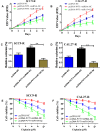LncRNA PVT1 Enhances Proliferation and Cisplatin Resistance via Regulating miR-194-5p/HIF1a Axis in Oral Squamous Cell Carcinoma
- PMID: 32021271
- PMCID: PMC6957095
- DOI: 10.2147/OTT.S232405
LncRNA PVT1 Enhances Proliferation and Cisplatin Resistance via Regulating miR-194-5p/HIF1a Axis in Oral Squamous Cell Carcinoma
Abstract
Background: Oral squamous cell carcinoma (OSCC) is the most frequent oral malignancy. Recent studies have revealed that long non-coding RNA (lncRNA) PVT1 plays important roles in the pathogenesis of various cancers. However, the functional roles of PVT1 in OSCC progression and cisplatin resistance have not been elucidated.
Material and methods: In this study, PVT1 expression level in cisplatin-sensitive and cisplatin-resistant OSCC tissues and cell lines was determined using qRT-PCR. Gain-of-function and loss-of-function assays were performed to explore the biological roles of PVT1 in OSCC cell proliferation and cisplatin resistance. Western blot, luciferase reporter assay and bioinformatics analysis were employed to investigate the underlying mechanism of PVT1 in OSCC progression.
Results: Here, we found that PVT1 was frequently up-regulated in cisplatin-resistant tissues and cell lines and strongly correlated with worse overall survival. Functional studies showed that PVT1 promoted OSCC cell proliferation and cisplatin resistance. Mechanistic investigation revealed that PVT1 could positively regulate HIF1a expression via its competing endogenous RNA (ceRNA) activity on miR-194-5p. In addition, miR-194-5p conversely correlated with PVT1 and HIF1a expression in OSCC samples. More importantly, HIF1a knock-down or miR-194-5p overexpression reversed PVT1-induced promotion of OSCC cell proliferation and cisplatin resistance.
Conclusion: Our results indicated that PVT1 functions as an oncogene involved in OSCC cell proliferation and cisplatin-resistance and may serve as a novel therapeutic target for OSCC treatment.
Keywords: HIF1a; cisplatin resistance; miR-194-5p; oral squamous cell carcinoma.
© 2020 Wang et al.
Conflict of interest statement
The authors report no conflicts of interest in this work.
Figures






References
LinkOut - more resources
Full Text Sources

